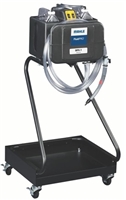Fluid Exchanger Maintenance
From transmissions to power steering, being able to quickly and easily exchange fluids in a system is a key feature expected of most auto repair shops. This is a part of routine maintenance for every vehicle, and the right machine can make the difference between a frustrating and arduous task and an easy job well done. For this reasoning, performing proper fluid exchanger maintenance is important to ensure your tools always work at their best. Here are some steps to take to get your equipment to peak condition and keep it that way for years to come:

1. Regularly replace canister filters
Most machines will prompt you to replace your filters. When this happens, use a standard band clamp tool to unscrew the old filters and tightly screw new ones in.
2. Clean the waste fluid screen
Much like replacing the filters, this helps keep your fluids moving and prevents surface tension from debris. Remove the screen and clean using a brush and degreaser, and blow out with an air compressor. Then you can place the screen back on, good as new.
3. Wipe down the exterior
Using a standard damp cloth, take time to wipe down and clean the exterior of your machine every now and then. One of the biggest issues that necessitate fluid exchanger maintenance is contamination from debris and the air, and wiping down the exterior will help ensure you keep this issue to a minimum.
4. Check parts for signs of wear and replace if necessary
External parts are most likely to be damaged during ordinary use, so inspect your machine to find obvious signs of damage and wear. Hoses, caps, wheels, and adapters are all candidates for failure. Look for cracks, leaks, or other problems that can be fixed with a quick replacement part.
5. Notify a professional
If all else fails and you have a problem with your exchange, consult a trained mechanic for the best results. Many machines come with warranties, and you can get repairs or a replacement in case of a fault. Even after this period expires, having a trained mechanic to repair your equipment will ensure you get the best performance possible. Malfunctioning exchanges can be a hazard to both you and the vehicles you work on, so take care to keep yours in the best condition possible all year long.
The first step for proper fluid exchanger maintenance is prevention. It is easier to stop a problem from happening in the first place than it is to fix it. Make sure to routinely clean your system and inspect it for signs of wear so that you can ensure you always have the best tools possible to perform whatever work your garage needs.











 Owned & Operated in the U.S. since 1987
Owned & Operated in the U.S. since 1987




